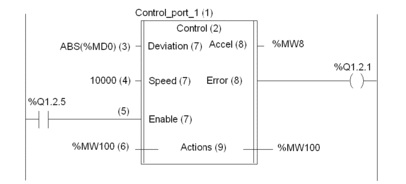Principle
In Ladder language, there are two possible ways of calling a DFB function block:
via a textual call in an operation block in which the syntax and constraints on the parameters are identical to those of Structured Text language
via a graphic call
The inputs of the function blocks may be connected or assigned a value, an object or an expression. In any case, the type of external element (value, evaluation of the expression, etc.) must be identical to that of the input parameter.
A DFB block must have at least one connected Boolean input and an output (if necessary). For this you may use the EN input parameters and the ENO output parameter (see the description of these parameters below).
It is compulsory to connect or assign the ANY_ARRAY-type inputs, the generic data-type outputs (ANY_...) and the input/outputs of a DFB block.
Graphic Representation of a DFB Block
The following illustration shows a simple DFB programming example.

Elements of the DFB Block
The following table lists the different elements of the DFB block, labeled in the above illustration.
Label |
Element |
|---|---|
1 |
Name of the DFB (instance) |
2 |
Name of the DFB type |
3 |
Input assigned by an expression |
4 |
Input assigned by a value |
5 |
Connected input |
6 |
Input assigned by an object (address or symbol) |
7 |
Input parameters |
8 |
Output parameters |
9 |
Input/output parameters |


